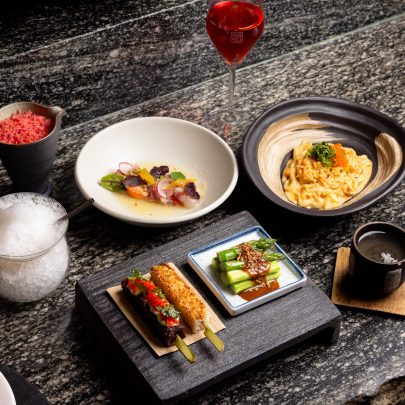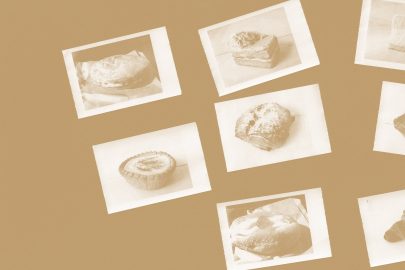May 27, 2019 Food
From how to get your teapot refilled to turnip cake (sweet or sour?), yum cha can be daunting for novices. Find out how to get the most from the great Chinese brunch with yum cha maven Jean Teng.
For more great videos, check out our Youtube Channel.
This article was first published in the March 2019 issue of North & South.
Yum cha was only legitimised in certain culinary canon with a Michelin star in 2009, but some of my earliest memories take place at that vast, round table, a lazy Susan plopped in the centre.
We would be called forth in bursts of brisk Cantonese telling us our table was ready, but it never was completely: workers would still be rolling up the last group’s tablecloth, stained with dollops of chilli oil, black bean sauce, spilled tea and other splattered evidence of an unfussy meal. Chopsticks, bowls and small plates would be placed in front of us without a word. And the theatre would begin.
There’s always a supremely satisfying hustle to yum cha; it recalls family reunions, Chinese New Year celebrations, and the relief of belonging in a country where, initially at least, I didn’t feel like I belonged very much. My accent would run amok, let loose from the looming consideration to sound as Kiwi as possible.
It took me an age to learn how to use knives and forks, what Marmite was, and how to puncture the poached egg in a Benedict, but I always knew the sweetness of a char siu bao. And goddamn, is the food good. Smashed avocado should shake in its boots.

The Guide
We’ll start at the beginning. Often, you’ll turn up with a belly that’s been empty since 8pm the previous night (in preparation, clearly) to a crowd of equally hungry punters elbowing their way to snag a seat. So you really should make a reservation. If staff bark down the phone that there’s a one-hour limit, I wouldn’t argue. It’ll be enough.
The first thing you’ll be asked is what kind of tea you want. If you’re the Teng family, the answer’s easy: jasmine, pronounced “heung peen” in Cantonese. Yum cha literally translates as “drink tea”, so be liberal with what you wash down, as it’ll cut through the grease and act as a cleanser between bites. Other options include chrysanthemum tea (guk-fa), a black tea called pu-erh (or bo lay), a green tea (longjing) or an oolong (tieguanyin).
Tip: If you’d like to get your tea refilled without waving down a waiter, lift the lid of the pot and replace it on an angle, or completely flip the lid.
A record of your order will be marked on a small rectangular piece of paper split into categories: small, medium, large, special and from the kitchen. Keep that on the edge of your table for easy access, near where the trolleys wheel by. It will also usually say how many of you are dining, as tea is charged per person. At the end of the meal, take that up to the counter to pay.

There’s generally no need to call over the wait staff serving food; they’ll stop by. Every family has their favourites, and mine often ends up with the exact same array of steamers on our table, curated through years of experimentation and refining. Discovering you don’t like something is a small $6 lesson, and if you’re with a group (always recommended), the chances are someone else will eat it, anyway.
Depending on the restaurant, sometimes you just gotta be fearless. Ask them to lift the lids on the mysterious bamboo steamers for a visual aid, because often they’ll rattle off a list of what they have and miss a few, not to mention the occasionally impenetrable language barrier. The “aunties” who typically commandeer the trolleys are an impatient bunch, and who can blame them? They’ve got the whole room to get through.
Brusque service is not rude; that’s the culture. If you know exactly what you want, you can always order directly from the staff, but isn’t it more fun to wait and see what falls in your lap? Baked goods, such as egg tarts, will often be sitting in a heated cabinet and can be whisked out straight away. With steamed goods, the mileage may vary.

My Lazy Susan Selection
Some yum cha restaurants will have more than 70 dim sum dishes on their menu, so this is by no means an exhaustive list – it’s what ends up on my own plate:
Chicken feet (fung chau): Now, my eyes roll if a non-vegetarian tells me the idea of chicken feet is gross, but I have to admit 10-year-old me was similarly sceptical. Like many other “gross” yum cha dishes, chicken feet are all about the texture, tender with gelatinous skin that can be sucked off (spit out the bones). And no foot-fetish jokes at the table, please.
Rice noodle rolls (cheong fun): Rice paper rolled like a crepe, a bit doughy, around a filling of some sort – places have been known to experiment. Generally, though, it’ll be prawn, or my personal favourite, youtiao (fried dough), because bread and rice do deserve to go together. They come doused in soy sauce and a sesame paste, which I recommend you ask the waiter to drizzle generously.

Taro dumplings (wu gock): This is a bit of an acquired taste: a crisp, wispy shell encases a filling of savoury minced pork, insulated by a layer of taro paste, deep-fried so it crunches in your mouth.
Pork buns (char siu bao): Hot, pillowy and a test in restraint.

Turnip cake (lo bak go): A rather misleading name – it’s made from a well-balanced ratio of grated daikon radish and rice flour, not turnip. Either way, the hits of umami from the hebi (dried shrimp) and pork is a delight.
Curry fish balls (gaa lei yu dan): Not always readily available in New Zealand, but grab them if you can. A common street-side snack in Hong Kong, they’re perfect skewered on one chopstick.

Congee: Eat this if you have a cold – or a hangover – and you’ll leave feeling like the gods have blessed you. Essentially porridge, the Chinese version is hot and mushy, spooned into the mouth with a side of croutons and sprinkle of spring onion.
Beef tripe (ngau pak yip): This is my dad’s dish of choice, and it’s a textured, chewy party in the mouth – and by party, we mean a summer holiday day trip you didn’t really want to go on but did because your parents forced you to, and now that you’re here you grudgingly admit you kind of like it.

Dumplings: Cantonese yum cha dumplings differ from the boiled or pan-fried ones you’ll find at your local Shanghainese restaurant (where they’re known as bar soup dumplings), but the concept is more or less the same.
The skin is often thicker and stickier, and will sometimes do a poor job of holding in the bursting filling; the casing should be just transparent enough for you to peer at the goods inside. One I had recently became a deconstructed dumpling at the first touch of my chopsticks. Just shove it all in your mouth, anyway – taste is king.
Dumpling fillings are generally a combination of shrimp and herb or vegetable, or shrimp by itself (har gao). My favourites are shrimp with chives (gao choi gao), with coriander or with spinach. Dip in a bit of chilli oil, which will sometimes be self-serve but is hardly ever on the table. Look for it at the tea-filling and cutlery areas on the periphery of the dining room.

Siu mai: Bite-sized lumps of chewy saltiness. They’re a comforting parcel of pork, shrimp, mushroom and other miscellaneous seasonings, garnished with a signature small dot of orange (usually carrot) at its centre.
Soft tofu soup (tau fu fa): This is a dessert. Slide your spoon across the top to avoid breaking up the silkiness, and slurp it up with sweet gingery syrup.

Molten egg custard buns (liu sha bao): If you don’t like egg, it’s best to stay away from this one. One tooth-sized incision in these white clouds will squeeze the creamy, salted egg-yolk filling out of its shell, hot and lava-like – do not bite them in half, so help you God.
Egg tarts (dan tart): When I was in a particularly fussy eating stage of childhood, this was the only yum-cha dish I would deign to put in my mouth. With flaky pastry caging bright-yellow custard, they’re still a lovely way to cap off the meal.
There’s plenty more: beef meatballs, pork ribs, lo mai gai (sticky rice wrapped in lotus leaves), clams in black bean sauce, fried sesame balls, sponge cake… My closing advice? Go back again and again and again.






